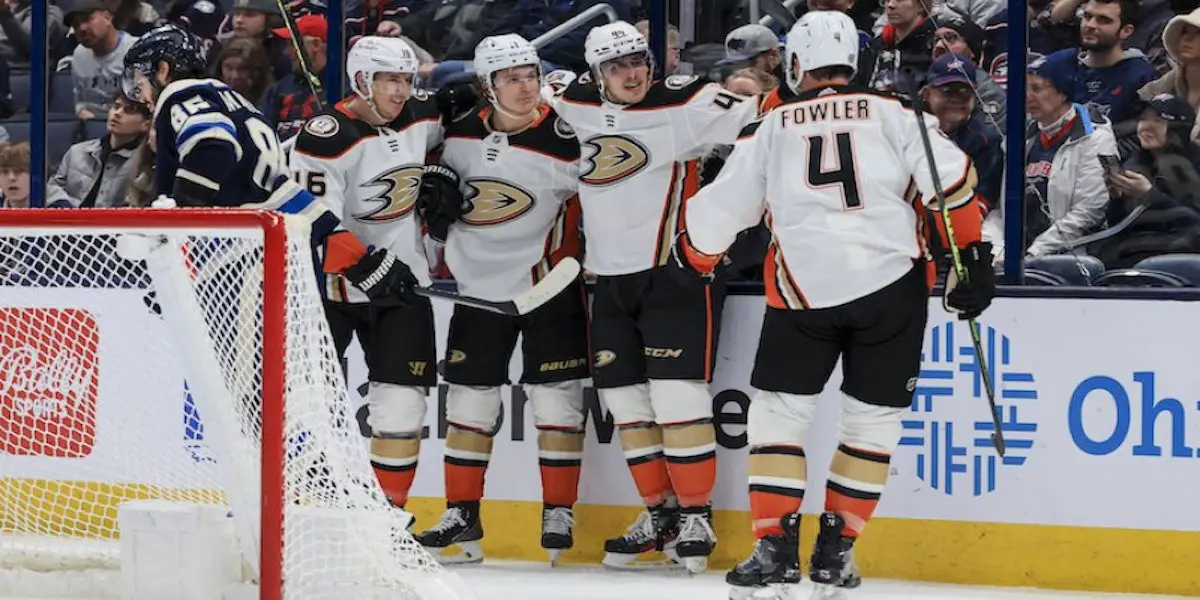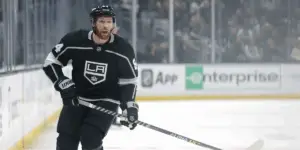
The Anaheim Ducks continued their six-game road trip with game three on Thursday evening with a stop in Columbus to take on the Blue Jackets. In a tightly contested battle for 32nd place in the NHL, this game featured two of the bottom three teams in the league and was set to have massive repercussions toward which of them would get the best odds at the number one overall pick in June’s entry draft. Anaheim entered this one after a lackluster effort against the Philadelphia Flyers on Tuesday in the second game of back-to-backs and looking to grab another tally for the win column. Columbus came into this one, having dropped eight of their last eleven games.
Isac Lundestrom made his return to the lineup in this game. He missed the last 21 games with a broken finger after blocking a shot on December 1st against the Dallas Stars. Mason McTavish was a surprise scratch as he is said to be dealing with a lower-body injury. No specifics were given to the location or extent, but Lundestrom slid into his spot as the top-line center for the Ducks in this game. Anthony Stolarz was given the rare opportunity to start back-to-back games for the Ducks after he got the nod in Tuesday’s loss in Philadelphia. This is how the coaching staff deployed the roster in this matchup…
The Ducks had a poor first period on the scoresheet, ending with Anaheim in a 3-0 hole. They were clearly adjusting to some scheme changes, and it cost them early. The coaching adjustments paid off, and the Ducks completed an impressive comeback and took the two points with a final score of 5-3. They recovered nicely in the final 40 minutes as they displayed a level of determination we haven’t seen from this team in quite a long time.
Offense
On this road trip, the Ducks coaching staff has made some tweaks to the systems they’ve been running. They have made a more concerted effort to have strong-side wingers and centers support the puck as outlets lower when the defensemen have control of it. This has allowed for shorter/higher percentage passes to players moving up ice with speed as they transition from the defensive zone into the neutral zone. Early in the season, forwards would fly the zone, and defensemen would send area passes to the neutral zone to create battles and start a forecheck. There were some communication breakdowns with these wrinkles in the first period of this game, which led to some turnovers and extended zone time. Still, they were ironed out as the game went on and proved very effective against the forecheck of the Blue Jackets.
Isac Lundestrom returned to the lineup playing 15:31 minutes while making the most of the opportunity he got as he was put on a line with two of the Ducks’ most potent offensive players (Troy Terry and Adam Henrique) and tallied a pair of assists. They were mostly matched up against Columbus’ top line (Laine-Jenner-Gaudreau) in this game. Isac provided a simple, meat-and-potatoes style to his new-look line as he was stable (as always) in the defensive zone and made simple plays to put his skilled linemates in good positions to make plays. He limited any opportunity the Blue Jackets had off the rush with effective backchecking efforts and was a major factor in transition, creating offense the other way. The best example of this was on the Ducks’ first goal when he broke up a breakout and made an area pass that Troy Terry could pick up with speed for a two-on-one, where he found Adam Henrique on the backdoor for the easy goal.
Trevor Zegras, since his move to center between Ryan Strome and Max Comtois, has been sublime. Since we last saw him play a true center position, his attention to detail in his own zone has improved greatly. He is remaining with his assignment in defensive zone coverage and winning battles in corners and along walls. The biggest asset he brings to this role is as a dynamic transition player. During breakouts, he has been doing a phenomenal job supporting the puck low and putting himself in a position to receive an outlet pass with tons of speed exiting the defensive zone. From there, he is able to do the things on the ice Trevor Zegras has made a name for himself doing, using his unique vision and creativity to produce offense. He has found a nice little chemistry with Ryan Strome and, more recently, Max Comtois, as the three of them have been dangerous on the cycle as well as off the rush. Zegras finished this game with a goal and an assist.
The Ducks’ powerplay had to take a slightly different form in this game with the absence of Mason McTavish. To start the game, they had Troy Terry take his spot on the right side of the umbrella and ended with Terry on the left and Zegras on the right. They had a tough time generating any bonafide scoring chances, though, as they couldn’t find many seam passes. Cam Fowler treated the powerplay like target practice, as he was seemingly shooting everything he touched (with several shots getting blocked). The powerplay ended scoreless on three opportunities.
Defense
As mentioned before, the tweaks to the breakouts took a while to prove effective, but when they did, it led to a multitude of chances for Anaheim on the rush. The team seemed to be making more of an effort to make d-to-d passes behind the net. This opened up options for defensemen to either skate it from behind their goal line or make a more dangerous outlet pass to a forward up the ice. Even when the Ducks won a face-off clean in the defensive zone, the weak-side defenseman would hustle behind the net to make himself an option for the breakout. Early in the game, one of these breakouts where forwards supported low to decrease the distance of the pass ended in Adam Henrique missing a swinging Troy Terry and turned the puck over to Jack Roslovic, who beat Anthony Stolarz clean from the right face-off dot. Luckily the coaching staff stuck with it and didn’t overreact to this miscue.
The neutral zone trap worked very well all game long for Anaheim. They forced Columbus to either make inaccurate passes or dump pucks in deep. Rarely did they surrender a clean zone entry. This allowed their defensemen to retrieve pucks and use their puck-moving prowess to create from 200 feet away from the opposing net. This was demonstrated beautifully when Cam Fowler scored his goal at the 13:07 mark in the second period. John Klingberg retrieved a dumped puck behind the net, found Fowler, who turned up the ice with a ton of speed, beat the F1 forechecker, and found Zegras swinging with an outlet pass. Fowler joined the rush as Zegras whipped it to Comtois, who found Fowler on the doorstep for the Ducks’ second goal of the night. When the Anaheim Ducks roster was put together over the summer, and the defensive depth chart had Cam Fowler, Jamie Drysdale, AND John Klingberg on it, these were the kinds of goals everyone envision the Ducks scoring. Truly beautiful hockey.
The defensive zone coverage was solid for most of the night. Even when the Blue Jackets found extended time in the offensive zone, their high-danger opportunities were limited by the Ducks’ diligent man-on-man scheme. It broke down only once when Kevin Shattenkirk lost his assignment, who found space in the left circle and caught Kevin in no man’s land between the shooter and his goaltender. This led to Columbus’ third goal, scored by Nick Blankenburg.
Goaltending
Anthony Stolarz stopped 12 of 15 shots in the first period before being pulled at the start of the second. While the goals he gave up would have been tough saves to make, he let three shots beat him cleanly. The first was a perfect snipe off a two-on-one (Fowler made a poor pinch at the offensive blueline) from Mathieu Olivier that was tucked into the top blocker corner, the second was off a turnover, and the third (the one he had the best chance of stopping) beat him high glove.
John Gibson was impressive in his two periods of relief. He didn’t face many high-danger shots in the second period, but as the game wore on, the saves became more difficult when Columbus was making a push. He made a couple of big saves on the Blue Jackets’ lone powerplay as he tracked the puck well along the top of the umbrella and squared up to the shots with skill, and made it look easy. Gibson stopped all 18 shots he faced.
Summary
While this game ended up hurting their odds of winning the lottery and the first overall pick, it was a pleasant surprise to see the Ducks put forth this kind of level of skill and heart. It would have been easy for the coaching staff to toss their adjustments in the trash, but sticking with it proved to be the right course of action. This is how the Anaheim Ducks should have been playing hockey this season. Yes, it was against the lowly Blue Jackets, but the team played to their strengths and found a way to climb out of a steep deficit. Isac Lundestrom was effective in his return to the lineup, and it will be interesting to see how he is used moving forward and when McTavish returns himself.
The Ducks will continue their road trip on Saturday morning (9:30 am pst) in Buffalo to take on the Sabres. It will be televised nationally on NHL network.
Discover more from Inside The Rink
Subscribe to get the latest posts sent to your email.



